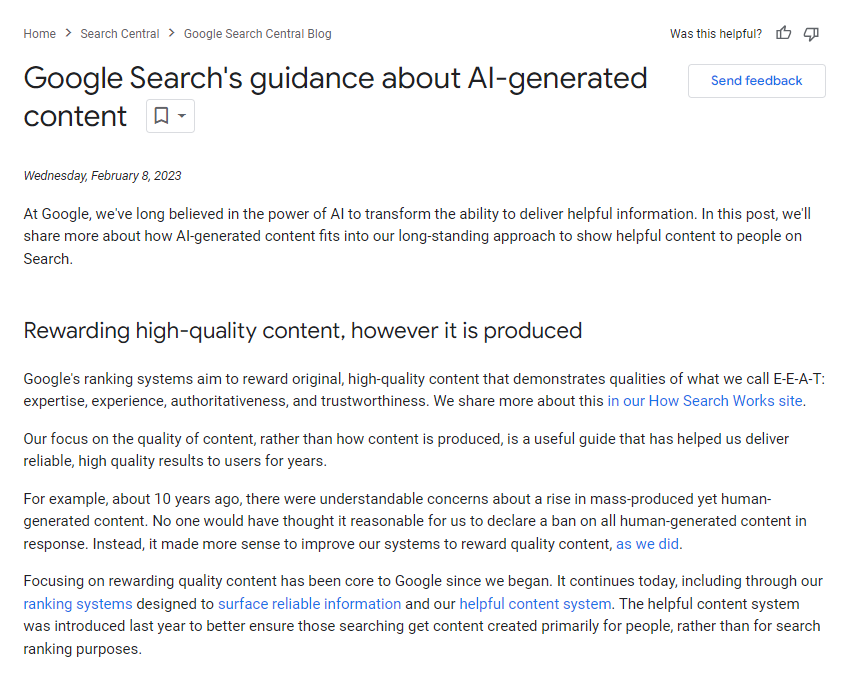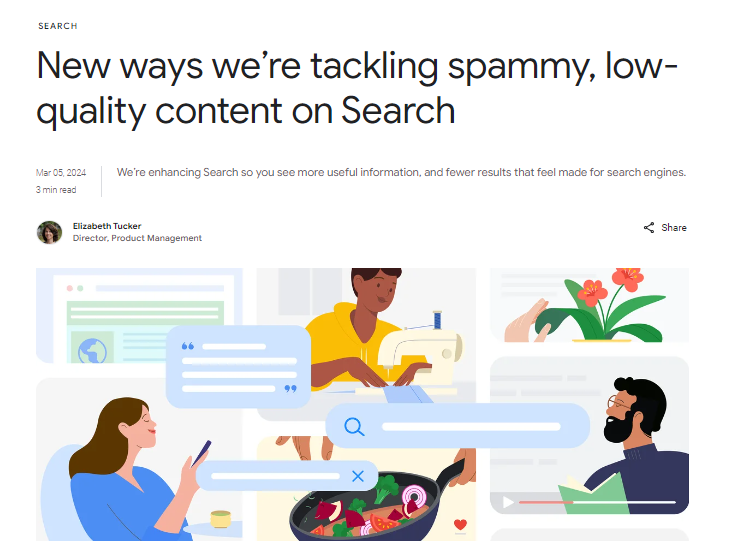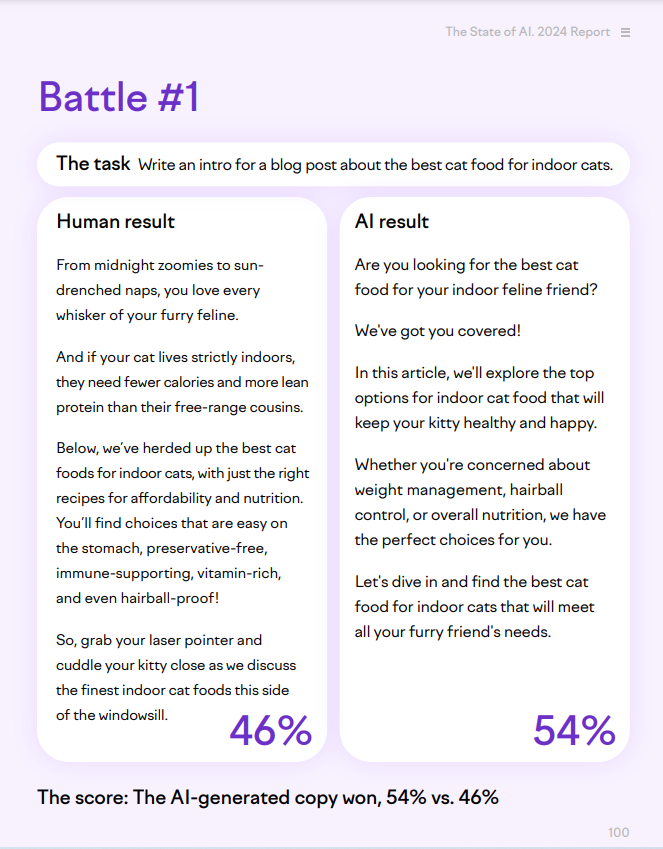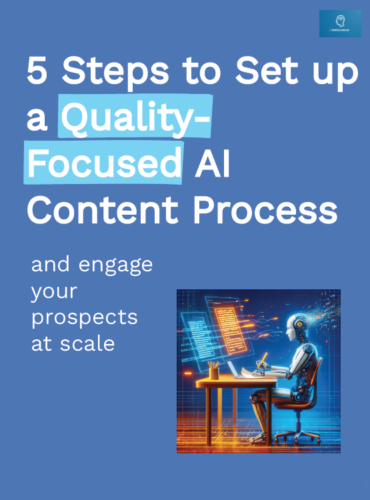With many promising advances, leveraging AI content for your SEO strategy seems very tempting.
But knowing Google’s stringent content quality guidelines, it also feels very dangerous.
Here we unpack Google’s true stance on AI-generated content and offer clear, actionable strategies to ensure your content complies with search engine algorithms.
What are the official guidelines of Google regarding AI content?

When it comes to content, Google’s guidelines have always been very clear: webmasters should create “helpful, reliable, people-first content”.
Google evaluates its value based on how well it serves users, emphasizing its E-E-A-T guidelines: Expertise, Experience, Authoritativeness, and Trustworthiness.
Where does that place AI-generated content?
Well, soon after the launch of ChatGPT in November 2023, Google itself confirmed that AI-generated content isn’t against its guidelines. The quality of your content is what matters most.
Your AI-generated articles, blogs, or web pages must showcase E-E-A-T just as any human-written content would.
However, Google draws a line when it comes to manipulation. If you’re using AI solely to climb the search engine rankings, you’re stepping into forbidden territory. Google’s spam policies are clear on this: content created with the primary aim of manipulating rankings will not be tolerated.
But the company explicitly acknowledges the usefulness of automation in creating content like sports scores, weather forecasts, and transcripts, highlighting the potential for AI to contribute positively.
As you craft your content, Google urges you to prioritize originality and quality. Your goal should be to produce content that not only ranks well but also genuinely serves your audience’s needs.
Google has even provided guidelines for assessing your content’s impact through questions of “Who ((created the content)? How (the content was created)?, and Why(was the content created)?” helping you ensure that your content is people-first and adheres to Google’s quality expectations.
Did Google’s 2024 March Core update penalize AI content?

In March 2024, Google launched a significant update specifically targeting low-quality content.
Announced on March 5, 2024, this update was part of Google’s ongoing efforts to combat manipulative SEO practices. This included the reuse of expired domains, the publication of scraped content to manipulate search results, and the mass production of content.
The “mass product of content” particularly targeted the rampant use of generative AI tools. Webmaster have been increasingly leveraging them to quickly create vast amounts of content, often resulting in pages lacking substantial value to users.
Google explicitly criticized this in their guidelines : “creating large amounts of unoriginal content that provides little to no value to users, no matter how it’s created”
However, it’s crucial to note the nuance in Google’s statement – The key lies in the phrase, “that provides little to no value to users, no matter how it’s created”.
This means that as long as your AI-generated content genuinely meets user needs and adds value, Google does not necessarily penalize it.
This stance was reflected through the impact of the March update. Several websites noticed significant shifts in their search engine rankings post-update. Websites that relied heavily on generic, low-effort content saw a decline in their visibility.
Conversely, sites that focused on detailed, well-researched, and original content reported improvements in their rankings. For instance, a notable health and wellness site that had invested in deep, expert-backed articles saw an increase in organic traffic by 12% in the weeks following the update.
Can Google detect AI content?

Google employs advanced machine learning tools like SpamBrain to detect spammy behavior and content patterns that might suggest manipulation, including those possibly generated by AI.
However, it’s the nature of your content that Google is really examining. If your AI-generated articles or blogs come off as spammy or lack genuine value, they may negatively trigger Google’s sophisticated algorithms.
It’s also worth considering that Google’s algorithms are quite adept at analyzing language nuances. They could potentially pick up on patterns that are characteristic of AI, such as repetitive phrases or unnatural syntax. This doesn’t mean all AI-generated content will be flagged, but it highlights the importance of monitoring the quality of what your AI tools produce.
Google recommends transparency in your use of AI. If AI plays a role in creating content, especially in sensitive areas like healthcare or finance, disclosing this might be beneficial.
This aligns with ethical practices and maintains trust with your audience, reflecting positively on the E-E-A-T quality of your content.
4 steps to make your AI content meet Google guidelines
As you can see, Google’s stance towards AI content is quite uncertain. The only certainty is to make your content as helpful and human-like as possible to minimize the chance of penalties.
Here are 4 steps you can take to add value and humanization to your AI content :
1. Feed original ideas to your AI

Language models such as GPT (Generative Pre-trained Transformer) draw from a vast pool of publicly available data to produce content.
While these tools are efficient, they tend to recycle common knowledge unless you guide them with fresh, original input.
To elevate your content’s value and align it with Google’s Expertise, Experience, Authoritativeness, and Trustworthiness criteria, it’s essential that you infuse it with your own expert insights.
Here’s how to effectively implement this strategy:
- Detail your expertise: make sure to clearly outline your specific knowledge and firsthand experiences related to the topic at hand. The more detailed your input, the richer and more informed the AI-generated content will be.
- Incorporate diverse sources: alongside your own expertise, include insights from a range of credible sources. This not only broadens the content’s perspective but also boosts its credibility.
- Refine AI drafts: after the AI generates the initial draft, don’t settle for it as the final product. Take time to critically review and refine the content, ensuring that it accurately reflects your unique voice and expertise.
- Keep inputs updated: continuously update the information you provide to the AI with new data and insights. This will keep the AI’s outputs relevant and engaging.
2. Customize your AI tone

To increase your content engagement, you also need to provide your AI with a unique tone and writing style. A unique flavor will ensure that your AI content does not come off as just another piece of generic output.
Here’s how you can do this :
Give clear editorial guidelines: start by defining specific editorial guidelines that capture the essence of your brand’s voice. These guidelines should cover aspects like tone, style, and the type of language you prefer (formal, informal, technical, etc.).
Providing these guidelines to your AI will adopt a voice that aligns with your brand identity.
Provide writing samples: Since tools like ChatGPT have a limited context window, they might not remember or consistently apply your guidelines.
To overcome this, provide the AI with writing samples that exemplify the tone and style you aim to achieve. These samples serve as concrete examples for the AI to understand and emulate the nuances of your desired output.
3. Respond to research intent

Behind every search query is a user looking to solve a problem or answer a question. Your content must directly address this need to be effective.
Begin by identifying the intent behind the keywords your audience uses. Is the user looking for information, trying to complete a task, or planning to make a purchase? Understanding this will guide your content creation process.
You can then create content that deeply responds to research intent by:
- Explaining concepts clearly: Once you’ve identified the user intent, explain the necessary concepts clearly and concisely. Use straightforward language that your audience can easily understand. Break down complex ideas into digestible parts, making sure that each section of your content builds on the previous one to enhance understanding.
- Providing step-by-step guidance: to guide users through their problems: Include bullet-pointed advice or step-by-step instructions based on real experiences. These should be practical, actionable, and tailored to the specific needs and experiences of your audience.
- Incorporating real examples: enhance your content’s usefulness by including real-life examples and case studies. These should be directly relevant to the user’s intent and provide clear illustrations of how your advice can be applied in practical scenarios.
- Being concise and Focused: avoid overwhelming your readers with overly long paragraphs or dense blocks of text. Instead: Keep your content synthetic and concise. Use subsections to organize your content logically. Highlight key actions to take and important information to remember.
By following these guidelines, you’re likely to see an improvement in the engagement rates of your articles. High engagement rates are a positive signal to Google, indicating that your content is valuable and meets the needs of users.
4. Humanize your content

Humanizing your AI-generated content is essential to avoid the telltale signs of machine production, such as predictable patterns and repetitive structures.
Here’s how you can inject more life and variety into your text to meet Google’s guidelines and engage your readers more effectively:
- Edit out repetition: Go through your AI-generated content and remove repetitive introductions and conclusions that don’t add value. Each section should serve a purpose and bring new information to the reader.
- Vary your structure: Introduce a mix of bullet points, numbered lists, and subsections. Randomly alter the structure of paragraphs and sentences to break the monotonous flow. Add a sentence here, remove one there, and rearrange sections to create a more organic, less predictable reading experience.
- Eliminate clichéd phrases: Steer clear of overused buzzwords and phrases like “in the realm of,” “game-changer,” “latest innovation,” or “unprecedented magic.” These terms can make your content sound exaggerated and undermine its credibility.
- Engage with the reader: Write as if you are conversing with your audience. Ask questions, address readers directly by using “you”, and encourage interaction. This engagement makes your content feel more personal.
Examples of AI websites penalized and not penalized by Google

It’s interesting to examine the concrete impact of AI content on website success or penalties.
Successful examples of AI content include major organizations like Bankrate and Reuters, which use AI tools to enhance content production without sacrificing quality.
Bankrate, for instance, has effectively utilized AI to rank well on highly competitive search terms by ensuring the content is well-edited and informative, aligning with user search intent. Similarly, Reuters uses AI to increase its content output significantly while maintaining high quality, which helps cover a broader range of stories .
On the flip side, there have been cases where websites suffered penalties due to the excessive use of non-humanized AI-generated content that lacked uniqueness and quality.
One notable example involves over 1,446 sites that experienced Google manual actions following a March 2024 update (study from Originaly.ai). These websites were completely removed from search results due to issues primarily with the quality and originality of their content. The sites affected were part of networks like MediaVine, Raptive, or Ezoic, and suffered major traffic and revenue losses as a result).
So as you can see from these examples, you can’t fully opt out from an AI content process if you want reliable SEO results. You need writers to stay in the loop and add fresh ideas and careful editing.





